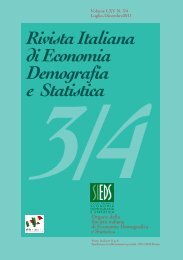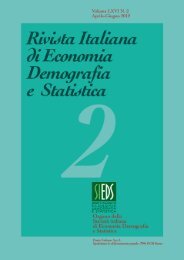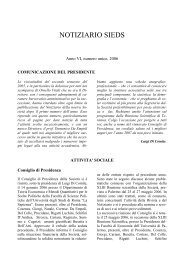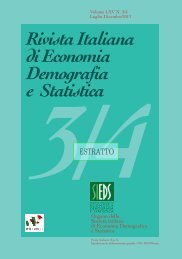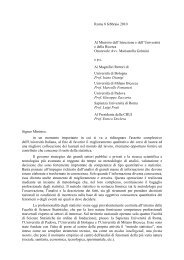rivista italiana di economia demografia e statistica - Sieds
rivista italiana di economia demografia e statistica - Sieds
rivista italiana di economia demografia e statistica - Sieds
You also want an ePaper? Increase the reach of your titles
YUMPU automatically turns print PDFs into web optimized ePapers that Google loves.
Rivista Italiana <strong>di</strong> Economia Demografia e Statistica 61<br />
dwelling owners and old age people (owners’ share is more relevant in this group); the<br />
opposite happens for tenants at market prices and young people.<br />
Table 3 – At risk of poverty rate, Me<strong>di</strong>an at risk of poverty gap and Gini index inclu<strong>di</strong>ng<br />
and not inclu<strong>di</strong>ng imputed rent by Country.<br />
Country<br />
Me<strong>di</strong>an at risk of<br />
At risk of poverty rate<br />
Gini index<br />
poverty gap<br />
Without<br />
Without<br />
Without<br />
With IR<br />
With IR<br />
With IR<br />
IR<br />
IR<br />
IR<br />
ES 20.9 15.3 24.4 22.5 32.2 27.6<br />
FR 13.2 12.9 19.4 17.7 27.8 25.9<br />
IT 19.3 16.0 21.6 22.2 32.1 28.9<br />
UK 18.5 15.8 21.4 19.4 32.9 29.2<br />
5. Conclusions<br />
This paper focuses on the <strong>di</strong>stributional impact of a particular type of non-cash<br />
income, the “imputed rent”, in four European Countries (France, Italy, Spain and<br />
United Kingdom) by the use of Eu-Silc data. Imputed rent refers to the value that<br />
should be imputed to all the households that do not pay full rent for their main<br />
residence. Our estimation is based on hedonic pricing method: the price of a marketed<br />
good, or the services it provides, is related only to its characteristics; moreover, we<br />
control for sample selection bias by the Heckman procedure. It is applied separately for<br />
each sub-group in order to prevent from considering owners, non-market tenants and<br />
free tenants as a unique and homogeneous set. Concerning the results, there is evidence<br />
of a sample selection problem.<br />
Once included the imputed rent in <strong>di</strong>sposable income, this one increases<br />
everywhere, but with relevant <strong>di</strong>fferent intensities: the greatest increase is registered<br />
for Spain (+29,9%) and the smallest for Italy (+19%), compared to around +23% for<br />
United Kingdom and France. Analysing the effects on poverty, we can observe a<br />
general decrease for the in<strong>di</strong>cators, more pronounced for Spain. Following the ranking<br />
provided by Gini indexes, UK and France remain respectively the most and the least<br />
unequal Countries. Two are the effects of IR on inequality measures. On one side, it<br />
enlargers the <strong>di</strong>fferences in income between market tenants and the other subgroups;<br />
on the opposite, since the <strong>di</strong>stribution of IR is less <strong>di</strong>spersed than the one for monetary<br />
income, inclu<strong>di</strong>ng IR reduces the total inequality among the population<br />
References<br />
Australian Bureau of Statistics (ABS) 2008, Experimental estimates of imputed rent,<br />
available at http://www.abs.gov.au/AUSSTATS/abs@.nsf/DetailsPage/6525.02003-<br />
04%20and%202005-06?OpenDocument<br />
Canberra Group 2001. Expert Group on Household Income Statistics, Final Report and<br />
Recommendations. Ottawa.



